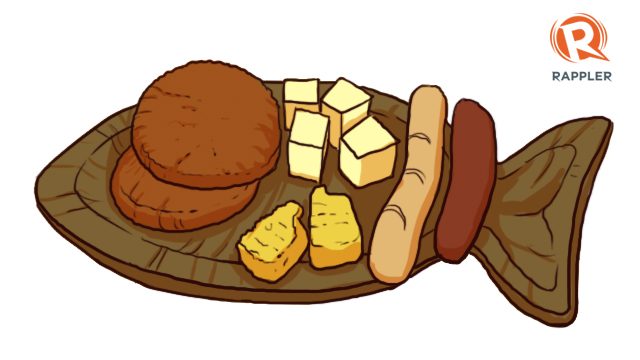SUMMARY
This is AI generated summarization, which may have errors. For context, always refer to the full article.

MANILA, Philippines – The Philippines is surrounded by water so it is no wonder that fish is a staple among households.
However, a typical Filipino family often only cook fish dishes by frying, steaming, or boiling. Although definitely a tasty meal, there are more to fish meat than the usual sinigang.
According to the Food and Nutrition Research Institute (FNRI), fishes are a good source of nutrients. It is then important that they become an important part of anyone’s diet. It is even part of the FNRI’s Pinggang Pinoy. (READ: What a Pinggang Pinoy should look like)
These sea bounties have iodine can prevent diseases such as goiter. Eating fish can also help build energy because of the available protein and easy fat. In addition, calcium can boost the processes of the body and contribute to stronger bones.
The Bureau of Fisheries and Aquatic Resources (BFAR) of the Department of Agriculture suggests various recipes that utilize one of the staples in FIlipinos’ diets. Here are some of them.
FISH BURGER
Ingredients:
- 2 cups fish meat
- 2 teaspoons coarse salt
- 2 teaspoons pepper
- 2 cup chopped onion
- 1 piece egg
- 4 tablespoons evaporated milk
- 1 tablespoon hamburger seasoning
- ½ cup breadcrumbs
Procedure:
- Chop fish meat in fine pieces.
- Add salt to the chopped meat and mix.
- Add remaining ingredients and mix.
- Mold into patties and fry.
FISH TOFU
Ingredients:
- ½ cup minced fish
- 1/8 cup tofu
- 3 tablespoons potato starch
- 2 tablespoons iodized salt
- 1 teaspoon Carrageenan
- 1 piece egg white only
- 2 tablespoons sugar
Procedure:
- Mix well all ingredients until it turns to smooth homogenous paste.
- Form into cubes.
- Set the formed paste at 40 degrees Celsius for 20 minutes.
- Cook at 90 degrees Celsius for 20 minutes and cool.
- Deep fry then serve.
FISH NUGGETS
Ingredients:
- 3 cups Fish meat
- 1 cup Shrimp meat
- 1 ½ cup cold water
- 10 tablespoons chopped onion
- 2 teaspoons Chopped garlic
- 1 ½ cup Breadcrumbs
- 2 tablespoons Vegetable oil
- ¾ cup Flour
- 1 tablespoons Iodized salt
- 1 tablespoons White sugar
- ½ teaspoon Nutmeg
- ½ teaspoon Cinnamon
- 1 ¼ teaspoons MSG
- Batter Mix
PROCEDURE:
- Grind minced fish meat using food processor.
- Add salt, chopped garlic, and onions, and continue grinding.
- Add the rest of the ingredients and grind thoroughly while gradually adding water.
- Mold into rectangular shape.
- Dip nuggets in a cold commercially-prepared batter mix in 1:1 ratio (batter mix and cold water).
- Roll into breadcrumbs.
- Freeze and pack in polyethylene bags until consumption.
- Deep fry until golden brown and serve with sauce.
NATIVE FISH SAUSAGE
Ingredients:
- 2 cups fish meat
- ½ teaspoon iodized salt
- 2 tablespoons soy sauce
- 2 tablespoons white sugar
- 1 teaspoon vinegar
- 1 tablespoon Anisado wine
- ½ teaspoon white pepper
- 1 tablespoon minced garlic
- ¼ teaspoon curing salt
- ½ teaspoon MSG
- Oatmeal
PROCEDURE:
- Mix the ground fish meat and other ingredients using food processor thoroughly.
- Cure overnight at chilling temperature.
- Stuff the mixture into synthetic casing or paperlyne.
- Deep fry before serving.
Livelihood through fishes
These recipes are not only for household consumption: for some underprivileged families, these innovative ways to use one of the country’s resources are key to improving their lives. (READ: 8 guidelines to make small-scale fishing more sustainable)
The recipes suggested by BFAR are used in various livelihood programs across the country. Different types of fish are utilized, depending on what’s available, in order to contribute to the income of these families.
In Marikina, for example, a non-governmental organization encourages mothers to learn how to make fish tofus out of “knife fish” – a type considered as “pests” in Laguna Lake. (READ: How a Marikina community makes a living from ‘pests’)
Improving fish consumption
Unfortunately, recent data shows that there has been a decline in fish consumption in the Philippines.
According to the latest Food Consumption Survey (FSC) of the Food and Nutrition Research Institute (FNRI), fish is not even part of the top 20 most consumed food products of Filipino households. (READ: What are the top 20 food products consumed by Filipinos?)
Reports attribute this to the increasing price of fishes in the market. In fact, the prices of galunggong (round scad) and tilapia – both considered as poor man’s fish in the past years – have increased in recent years. (READ: Poverty and nutrition: What happened to the poor man’s fish?)
Given the rising prices of food products – especially those considered to have the most nutrients – can minimum wage earners still consume diverse yet healthy and nutritious meals?
Maybe they still can, but they have to be more creative. – Rappler.com
Add a comment
How does this make you feel?










There are no comments yet. Add your comment to start the conversation.